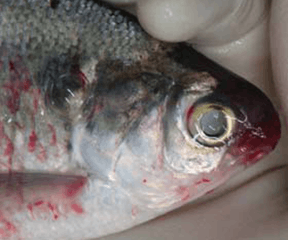Spring viraemia of carp
| Rhabdoviridae | |
|---|---|
_EM_18_lores.jpg) | |
| Vesicular stomatitis virus (VSV), the prototypical rhabdovirus | |
| Virus classification | |
| Group: | Group V ((-)ssRNA) |
| Order: | Mononegavirales |
| Family: | Rhabdoviridae |
Spring viraemia of carp, also known as Swim Bladder Inflammation, is caused by a rhabdovirus called Rhabdovirus carpio. It is listed as a notifiable disease under the World Organisation for Animal Health.
Impacted species
Spring viraemia of carp virus has been shown to infect a wide variety of fish species including silver carp, grass carp, crucian carp, and bighead carp. It has also been shown experimentally to infect other fish species including northern pike, guppies, zebrafish, and pumpkinseed.[1] It is considered to be a major threat to naive fish populations, especially farmed fish including ornamental koi and common carp.[2]
Pathology
Clinical symptoms of viral infection include external hemorrhaging, pale gills, and ascites.[3] In some cases, mortality can occur without any apparent clinical signs of the disease.[4] The virus has been found in high concentrations in the liver and kidney, but lower numbers of virions have been isolated from the spleen.[5] The virus has been shown to persist subclinically in fish populations up to 10 weeks following experimental infection.[1] Currently efforts have been made to prevent infection by the virus through the development of DNA vaccines[6] and immunostimulatory therapeutics.[7]
Prevalence
The virus has been implicated in several outbreaks of SVC throughout the past few decades. Originally the range of the virus was isolated to Europe and the Middle East. In 2002 it was isolated from a North Carolina lake.[8] In 2004 the virus was isolated from imported koi in Cedar Lake, Wisconsin.[9] Additionally, the virus has been linked to an outbreak of SVC in 2006 at Hamilton Bay in Lake Ontario.[10]
External links
- Spring Viraemia of Carp expert reviewed and published by Wikivet, accessed 08/10/2011.
References
- 1 2 Ahne, W; et al. (2002). "Spring viremia of carp (SVC)". Diseases of Aquatic Organisms. 52 (3): 261–272. doi:10.3354/dao052261. PMID 12553453.
- ↑ Walker, P; Winton J (2010). "Emerging viral diseases of fish and shrimp". Veterinary Research. 41 (51): 51. doi:10.1051/vetres/2010022.
- ↑ Fijan, N; Petrinec Z; Sulimanovic D; Zwillenberg LO (1971). "Isolation of the viral causative agent from the acute form of infectious dropsy of carp". Veterinary Archives. 41: 125–138.
- ↑ "Manual of Diagnostic Tests for Aquatic Animals". World Organization for Animal Health. Retrieved 16 December 2013.
- ↑ Fisal, M; Ahne W (1984). "Spring viremia of carp virus (SVCV): comparison of immunoperoxidase, fluorescent antibody and cell culture isolation techniques for detection of antigen". Journal of Fish Diseases. 7: 57–64. doi:10.1111/j.1365-2761.1984.tb00906.x.
- ↑ Emmenegger, EJ; Kurath G (2008). "DNA vaccine protects ornamental koi (Cyprinus carpio koi) against North American spring viremia of carp virus". Vaccine. 26: 6415–6421. doi:10.1016/j.vaccine.2008.08.071.
- ↑ Masycheva, VI; et al. (1995). "Comparative antiviral effects of dsRNA on lower and higher vertebrates". Veterinary Research. 26: 536–538.
- ↑ Goodwin, AE (2002). "First report of spring viremia of carp virus (SVCV) in North America". Journal of Aquatic Animal Health. 14 (3): 161–164. doi:10.1577/1548-8667(2002)014<0161:FROSVO>2.0.CO;2.
- ↑ Dikkeboom, A; et al. (2004). "First Report of Spring Viremia of Carp Virus (SVCV) in Wild Common Carp in North America". Journal of Aquatic Animal Health. 16 (4): 169–178. doi:10.1577/H03-064.1.
- ↑ Garver, K; et al. (2007). "First detection and confirmation of carp virus in common carp, Cyprinus carpio L., from Hamilton Harbour, Lake Ontario, Canada". Journal of Fish Diseases. 30 (11): 665–671. doi:10.1111/j.1365-2761.2007.00851.x. PMID 17958610.
